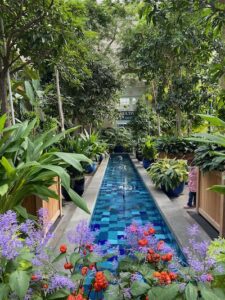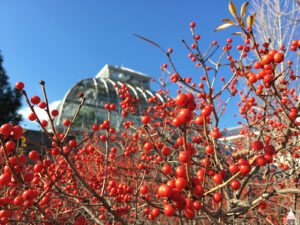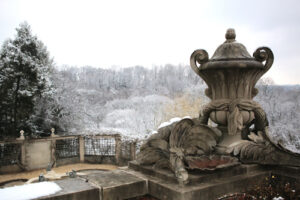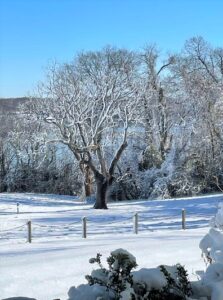Gardens to Visit in Winter
by Kathleen Curthoys, Fairfax Master Gardener

The Garden Court in the Conservatory of the U.S. Botanic Garden
The leaves have fallen, our garden tasks dwindle and it’s a long wait until spring. It’s the season when gardeners dream of greenery and reimagine next year’s garden. This season, a gift you can give yourself is to put on boots and go explore a public garden in all its winter glory. Our region has many gardens open all winter for walking, imagining and finding inspiration you can take home.
What can a public garden give you in winter? Here are a few reasons to venture out.
The newly bare trees and shrubs reveal the garden designers’ plan and vision in more detail than can be seen in the growing season. The vistas open to a transformed view of the landscape. Gardens present a more open canvas for imagining new designs and plantings for the next growing season. Bare silhouettes of the trees show you sculptural forms they take and tell you more about themselves.
The winter season puts new light on aspects of the garden often overlooked in the height of growing season: evergreens, bark, stems, berries, seedheads and seasonal flowers. Textures, colors and winter light give a new view of the garden.
Public gardens are less populated in winter, giving visitors a more serene experience. You may feel you have this grand garden to yourself. Walking through a winter garden is beneficial for gardeners, and everyone else, for its physical and mental benefits.
Hardscapes in the garden — walls, pavements, steps, paths — can be seen to great advantage in winter and shown as carefully planned foundations and structure for the garden, which can be informative and inspiring for home gardeners.
Many public gardens are planned for seasonal interest, with evergreens in the landscape, something blooming nearly all year and more spirit-lifting abundance inside conservatories and visitor centers. Outside, watch for hardy blooms and early signs of spring: snow drops (Galanthus nivalis), crocus (Crocus sativus), forsythia and more.
All this is on top of holiday-season displays of lights, decorations and special plantings that transform gardens for a few weeks each winter. Here is a look at three spectacular gardens for winter visits.
U.S. Botanic Garden
This landmark near the U.S. Capitol and the National Mall is the oldest continuously operating public garden in America. Its mission is to show visitors the importance, diversity and value of plants, here and around the world.

Winterberry at the U.S. Botanic Garden
For winter visitors, the allure can be as simple as feeding the need for green. Indoors, it is a wondrous place to cast aside your coat and feel the warmth of the tropics, under the palms of the vast Conservatory or by the pools of the lush Garden Court. The Conservatory also features Mediterranean plants, medicinal herbs, a desert landscape, exhibits on plant conservation and more.
Inspiration for home gardens runs rampant indoors and out. You may not be growing those banana palms in Northern Virginia, but you might add the drama of the elephant ear plants
Outside, the Regional Garden and other displays inform about Mid-Atlantic native plants beneficial to our own gardens. The plants provide important sources of food for birds and other wildlife in winter, and the landscape is brightened by the red berries of the winterberry holly (Ilex verticillata).
- Two exhibits are open through December and beyond:
- “Season’s Greenings,” the annual holiday exhibit, is Nov. 24 to Jan. 2. In the gated outdoor gardens, G-gauge model trains run 10 a.m. to 5 p.m. The Conservatory, decorated for the holidays, features Washington, D.C., landmarks made from plants.
- A new agriculture exhibit, “Cultivate: Growing Food in a Changing World,” runs through December 2023. The wide-ranging exhibit includes innovations for home gardening and growing food.
Dumbarton Oaks Garden

Winter view from the Green Terrace at Dumbarton Oaks
This treasure in Georgetown is world-renowned for its design, vistas and variety, with architectural features and sculptural art revealed at every turn along your path. Dumbarton Oaks has been ranked among the world’s top 10 gardens, in such company as Versailles and Kew, by National Geographic. A succession of unique garden rooms and terraces is revealed starting at the historic house. Outside the gardens is the backdrop of Dumbarton Oaks Park, 27 acres of woods and meadows.
The gardens were established by Mildred and Robert Woods Bliss, owners of a 53-acre historic estate. In the early 1920s, Mildred Bliss and landscape architect Beatrix Farrand began developing the gardens to have year-round interest — a place to walk, rest and contemplate in every season. “Those of us who know this garden really well love the winter the best because the garden is bare, the leaves are down… You can see the bones of the garden,” said Melissa Brizer, Greenhouse specialist, in a Dumbarton Oaks social post last December.
Some features to see in winter:
- The Orangery displays what is said to be the oldest houseplant in North America, the Ficus pumila, more than 150 years old.
- The East Lawn has evergreens planted to enhance the long perspective and vista.
- The Star Garden near the house is an intimate space with custom stonework, sculptural figures and a fountain. The space is enclosed by a hedge of large-blooming Rhododendron mucronatum ‘Indica Alba.’
- Follow the Box Walk amid English boxwood Buxus sempervirens ‘Suffruticosa’) down the gentle slope to the Ellipse, a peaceful place to reflect.
- Watch for early blooms, such as crocuses spreading across a lawn.
Dumbarton Oaks has been celebrating the 100th anniversary of Farrand’s design of the gardens, including a new release of her book, The Plant Book for Dumbarton Oaks, with commentary from garden director Jonathan Kavalier. The book can be used as a companion for a visit.
River Farm
Overlooking the Potomac River, River Farm is an inspiration in every season. In winter, now-bare trees and shrubs allow for grand views of the river. With 25 acres of gardens on a property once owned by George Washington, River Farm is the national headquarters of the American Horticultural Society (AHS). It is a spot not only for gardeners, but for bird watchers, plein air painters and wedding parties.

View of the Potomac at River Farm’s meadow
Visitors can be thankful River Farm is still here to enjoy. AHS announced in October 2021 that River Farm would remain the national headquarters of the society, thanks to an “overwhelming outpouring of support” from members and the community, ending a year-long period of uncertainty about its future when the property was temporarily up for sale. In 2023, AHS will mark 50 years since its benefactor Enid Annenberg Haupt provided funds to buy the property, stipulating that it be used as the AHS headquarters.
You can begin your visit at the manor house, where the lower level is open to visitors. Exhibits and art are displayed periodically. The terrace also features English boxwood specimens (Buxus sempervirens ‘Suffruticosa’) said to be nearly 100 years old. A series of small gardens has interest through the year, with plants chosen for season of bloom, color and resistance to diseases and pests. The children’s garden features more than a dozen themed gardens.
Looking toward the river, you can take a path into the Andre Bluemel Meadow with its dozens of species of grasses and perennials, most of them native to the region. The grasses, dried blooms and seedpods become the star of the show in winter. Green Garage displays equipment, materials and techniques for sustainable gardening, demonstrating how to design a garden, select the tool for the job, water efficiently and other skills.
Gardening activities continue through the winter. Volunteers can be seen tending to container plantings and structures and getting ready for spring. The winter-blooming Hellebores add color to the landscape. Watch for signs of later winter blooms such as snow drops. Bird watchers can also watch for members of River Farm’s eagle family.
Resources
U.S Botanic Garden, Washington, DC
Dumbarton Oaks Garden, Georgetown, Washington, DC
American Horticultural Society, Alexandria, VA